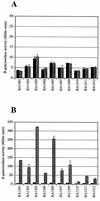Salmonella typhimurium encodes an SdiA homolog, a putative quorum sensor of the LuxR family, that regulates genes on the virulence plasmid
- PMID: 9495757
- PMCID: PMC107006
- DOI: 10.1128/JB.180.5.1185-1193.1998
Salmonella typhimurium encodes an SdiA homolog, a putative quorum sensor of the LuxR family, that regulates genes on the virulence plasmid
Abstract
Quorum sensing is a phenomenon in which bacteria sense and respond to their own population density by releasing and sensing pheromones. In gram-negative bacteria, quorum sensing is often performed by the LuxR family of transcriptional regulators, which affect phenotypes as diverse as conjugation, bioluminescence, and virulence gene expression. The gene encoding one LuxR family member, named sdiA (suppressor of cell division inhibition), is present in the Escherichia coli genome. In this report, we have cloned the Salmonella typhimurium homolog of SdiA and performed a systematic screen for sdiA-regulated genes. A 4.4-kb fragment encoding the S. typhimurium sdiA gene was sequenced and found to encode the 3' end of YecC (homologous to amino acid transporters of the ABC family), all of SdiA and SirA (Salmonella invasion regulator), and the 5' end of UvrC. This gene organization is conserved between E. coli and S. typhimurium. We determined that the S. typhimurium sdiA gene was able to weakly complement the E. coli sdiA gene for activation of ftsQAZ at promoter 2 and for suppression of filamentation caused by an ftsZ(Ts) allele. To better understand the function of sdiA in S. typhimurium, we screened 10,000 random lacZY transcriptional fusions (MudJ transposon mutations) for regulation by sdiA. Ten positively regulated fusions were isolated. Seven of the fusions were within an apparent operon containing ORF8, ORF9, rck (resistance to complement killing), and ORF11 of the S. typhimurium virulence plasmid. The three ORFs have now been named srgA, srgB, and srgC (for sdiA-regulated gene), respectively. The DNA sequence adjacent to the remaining three fusions shared no similarity with previously described genes.
Figures






Similar articles
-
SdiA of Salmonella enterica is a LuxR homolog that detects mixed microbial communities.J Bacteriol. 2001 Oct;183(19):5733-42. doi: 10.1128/JB.183.19.5733-5742.2001. J Bacteriol. 2001. PMID: 11544237 Free PMC article.
-
Molecular modeling and active site analysis of SdiA homolog, a putative quorum sensor for Salmonella typhimurium pathogenecity reveals specific binding patterns of AHL transcriptional regulators.J Mol Model. 2012 Oct;18(10):4709-19. doi: 10.1007/s00894-012-1469-1. Epub 2012 Jun 2. J Mol Model. 2012. PMID: 22660944
-
Direct regulation of the pefI-srgC operon encoding the Rck invasin by the quorum-sensing regulator SdiA in Salmonella Typhimurium.Mol Microbiol. 2014 Oct;94(2):254-71. doi: 10.1111/mmi.12738. Epub 2014 Sep 1. Mol Microbiol. 2014. PMID: 25080967
-
Eavesdropping by bacteria: the role of SdiA in Escherichia coli and Salmonella enterica serovar Typhimurium quorum sensing.Foodborne Pathog Dis. 2011 Feb;8(2):169-78. doi: 10.1089/fpd.2010.0651. Epub 2010 Oct 30. Foodborne Pathog Dis. 2011. PMID: 21034261 Review.
-
Role of the LuxR solo, SdiA, in eavesdropping on foreign bacteria.FEMS Microbiol Rev. 2025 Jan 14;49:fuaf015. doi: 10.1093/femsre/fuaf015. FEMS Microbiol Rev. 2025. PMID: 40240290 Free PMC article. Review.
Cited by
-
What makes another life possible in bacteria? Global regulators as architects of bacterial biofilms.World J Microbiol Biotechnol. 2022 Oct 14;38(12):236. doi: 10.1007/s11274-022-03376-4. World J Microbiol Biotechnol. 2022. PMID: 36229744 Review.
-
Salmonella enterica serovar Typhimurium can detect acyl homoserine lactone production by Yersinia enterocolitica in mice.J Bacteriol. 2010 Jan;192(1):29-37. doi: 10.1128/JB.01139-09. J Bacteriol. 2010. PMID: 19820103 Free PMC article.
-
Synthesis of N-acyl homoserine lactone analogues reveals strong activators of SdiA, the Salmonella enterica serovar Typhimurium LuxR homologue.Appl Environ Microbiol. 2007 Jan;73(2):535-44. doi: 10.1128/AEM.01451-06. Epub 2006 Nov 3. Appl Environ Microbiol. 2007. PMID: 17085703 Free PMC article.
-
Furanone and phytol influence metabolic phenotypes regulated by acyl-homoserine lactone in Salmonella.Braz J Microbiol. 2022 Dec;53(4):2133-2144. doi: 10.1007/s42770-022-00809-y. Epub 2022 Aug 10. Braz J Microbiol. 2022. PMID: 35947344 Free PMC article.
-
Bacterial LuxR solos have evolved to respond to different molecules including signals from plants.Front Plant Sci. 2013 Nov 12;4:447. doi: 10.3389/fpls.2013.00447. eCollection 2013. Front Plant Sci. 2013. PMID: 24273546 Free PMC article. Review.
References
-
- Altschul S F, Gish W, Miller W, Myers E W, Lipman D J. Basic local alignment search tool. J Mol Biol. 1990;215:403–410. - PubMed
-
- Ausubel F M, Brent R, Kingston R E, Moore D D, Seidman J G, Smith J A, Struhl K, editors. Current protocols in molecular biology. New York, N.Y: John Wiley & Sons; 1995.
-
- Bajaj V, Lucas R L, Hwang C, Lee C A. Co-ordinate regulation of Salmonella typhimurium invasion genes by environmental and regulatory factors is mediated by control of hilA expression. Mol Microbiol. 1996;22:703–714. - PubMed
-
- Bardwell J C, McGovern K, Beckwith J. Identification of a protein required for disulfide bond formation in vivo. Cell. 1991;67:581–589. - PubMed
Publication types
MeSH terms
Substances
Associated data
- Actions
Grants and funding
LinkOut - more resources
Full Text Sources
Other Literature Sources
Molecular Biology Databases

